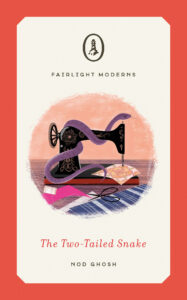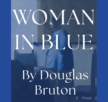

Nod Ghosh interview and exclusive extract
- 14th September 2023
- Category : Author,Blog,Interviews & Blogs
Nod Ghosh is the author of The Two-Tailed Snake, a new addition to the Fairlight Moderns publishing on 14 September 2023. The Two-Tailed Snake is a novella in flash exploring partition in India through the naïve eyes of 14 year old Joya. Read this interview with Nod to find out more, and to see an exclusive sneak peek of The Two-Tailed Snake.
How did you start writing, and what does writing mean to you?
This is a sad story involving a group of pre-teens in the 1970s who exchanged letters containing instalments of novels contributed by different members. The work featured established literary characters, politicians and pop celebrities. We experimented with poetry, playing with enjambment before we knew what enjambment was. The group also wrote newsletters for an organisation dedicated to the liberation of cats. I believe Pussy’s Lib only ever recruited two members.
It was highly charged and emotional.
We were achieving flow state, though we didn’t know it. We called it utter confusion.
I still look for that explosive blissful state of utter confusion when I write.

What inspired you to write The Two-Tailed Snake?
- Pent-up responses to my parents’ generation’s experiences in the Indian subcontinent.
- Random words from an old diary.
- Daily prompts from Nancy Stohlman’s flash nano event in November 2021.
I wanted to capture the anxiety, disquiet and hyperbole the elder generation bequeathed us; emotions displayed in the book in a chapter titled Shorbonaash!
If you could describe The Two-Tailed Snake in one word, what would it be?
Shorbonaash!
Was there a particular part of the story that you found difficult to write?
The ending. There’s an abundance of tension in The Two-Tailed Snake, which demands a satisfying denouement. It was important to fine tune the pacing and revelations so the narrative didn’t fizzle out from lack of energy, but finished instead with a controlled detonation. In novels, I often complete the finale part way through, and then write chapters leading up to it. Snake was different. The first draft was almost finished before I knew what would happen to the main characters.
You’ve previously written novellas-in-flash. Did your experience of writing The Two-Tailed Snake vary from that of writing novellas-in-flash? If yes, how?
The Two-Tailed Snake WAS a novella-in-flash in its earlier incarnations. While working with Sarah Shaw and Laura Shanahan at Fairlight, we realised the story didn’t require discrete stand-alone pieces to create a cohesive whole. We changed it to a linear structure and took out “re-introductions” to characters who were already known, but retained the concision.
What do you hope people take away from reading your book?
An understanding of the turmoil and instability of this period in history, and an appreciation for writing that straddles the line between poetry and prose.
What’s your favourite book and who is your favourite author?
That depends on the time of day and what I had for breakfast. I’m not good with superlatives. I’d rather mention work and writers I’ve enjoyed recently. It’s hard to compare a book I read and loved twenty years ago with one I’m reading in 2023. I like to think I’m more discerning and analytical now.
I enjoyed The Axeman’s Carnival by Catherine Chidgey, winner of the Jann Medlicott Acorn Prize for Fiction in the Ockham New Zealand Book Awards this year. I loved the voice the author developed for the narrator: a magpie called Tamagochi – endearing without being over sentimental.
In the past, I read many of Joanne Harris’s books. Her writing is well-crafted yet fast-paced and accessible.
Do you have a writer’s habit that helps you ‘get in the zone’?
Like many writers, I respond well to constraint. Imagine being in a restaurant with infinite options on the menu. Where would you start? Too many choices can be stifling. That’s why I enjoy prompts. Even if you don’t include prompt words or concepts in the final version of the writing, they help you discover what you do want to use.
Do you have a writing schedule?
For eight years I’ve started writing a new book on the 2nd of November, to coincide with the flash nano event.
Where do you tend to write?
In my head. No, that’s a lie. The neural connection between brain, fingers and screen or page is integral to the process. Some writers use voice recording. I could never use that. The hardware is an important part of the organism known as an author.
In terms of location, it’s usually the lounge at home. I tried writing in our local library, but couldn’t establish the habit.
Other favourites include the staffroom at the laboratory where I work. My day job is Medical Laboratory Scientist specialising in diagnosing cancers such as leukaemia. It’s intense work that involves love, lasers and chopping up little pieces of human flesh. It’s good to break away and do something different. If I’m writing to a deadline, I’ll knock out a chapter during lunch break, though I have to be careful not to get crumbs and coffee on my keyboard.
I’ve also parked my car at the end of our road after work and written there. The view is spectacular. I generally only do that if I’m trying to get out of making dinner.
*
Keep reading for a sneak peek of The Two-Tailed Snake…
Snakes come in many forms, yah! I’ve heard it said we are good company when we perform our duty without scheming and conspiring to pervert the course of justice.
I’ve heard that you perceive us as good or evil according to your needs. Ah, the hubris of humanity!
There are kraits and green tree vipers, whose venom will become beneficial in time. The gods know we serpents will be valuable one day, our defence used to create
antivenins and other gifts to mankind. Those with a love of ophiology and studying reptiles in general will nurture us, especially where there is a profit to be made. You
may call me cynical, but I am only an observer, a scaly one with bead-like eyes who has glimpsed the future.
And what of anguine prophets? There are as many stories told about us serpents as the ones we tell ourselves.
A snake-god, Ananta-Shesha, circles the world. All-seeing. All-knowing. Ananta hears prophecies about white serpents who cross the ocean, who are vanquished in battle and return to salt water, defeated. Ananta hears it all.
And what of sanguine prophesiers, who sit at firesides passing tales to their children and children’s children, frightening them by foretelling their misfortunes? I have heard so much said by those who know so little.
There is a legend whispered among the initiated, but perhaps not whispered often enough, or loudly enough. It is said that if one slaughters a snake, death will follow. Make a snake angry, insult us, or show disrespect, and a curse will lead to sickness and calamity. We may not act immediately, but bad fortune will find you. Eventually.
There are benevolent snake-deities within the sub-pantheon. Those who support the weight of the planets with their multitudinous heads humbly accept offerings of eggs and milk from worshippers. The Supreme Being, the trinity of higher gods, the trimurti of Lord Vishnu, Lord Brahma and Lord Shiva will bless those such as Ananta, whose yawn may cause the earth to shiver.
There is Vasuki, who dwells on Lord Shiva’s neck, who stirs his tail in the oceans and whips up an ambrosia of immortality.
There is Manasadevi, the queen of snakes. She is also the god of poison. Her eyes are as black as the queen of Ishkapon or Chiraton. But are they truly as black as spades or clubs? Or is there a glint of diamond in them that reveals her true heart?
And there is Kaliya, feared by many, who lurks in the black waters of the river, and is known for terrorising infant gods.
We are not all divine, but many snakes hold the power of divination. I could tell you how the earth will end. We reside in the last of the four ages of the epoch, but all is not as it appears in the scriptures. If only you knew how to read the Puranas accurately, yah!
There are many of us. Innocent snakes. Corrupt snakes. Dead snakes. Comical snakes. There are snakes that reproduce without coitus. Try that if you can. It’s been done, I’m told.
We are not all literal. Some are divine energy, coiled tight as a spring, waiting to be awoken so your consciousness may be raised.
We shed our skins and are reborn, for which we are revered and envied.
And we are abused.
There are fakirs who coax defanged snakes to dance. Some sew our mouths together into narrow slits so only the tongue protrudes. Such cruelty! Such depravity! We dance in and out of wicker baskets, the thin wail of a pungi reed pipe creating the illusion of mesmerisation. In reality, we have been subdued by means of intoxicating herbs. At least it takes some of the pain away. Ahhhh!
There are snakes that curl into a ball and disappear when they hear the thwack of a policeman’s lathi, only to follow the gullible man and lure him later with intoxicating offers. And though snakes divine or simple may admonish these deviants until they slither away guilt-ridden and forlorn, they will always return if there is a chance of a few coins to be gained.
We know there are good and bad among us, and those like me, who are indifferent.
There is one among us, a snake with two tails, who is a man, is a serpent, no, a man really – perhaps a bit of both. Listen closely to this tale. And in parallel, you will hear another story.
Perhaps it is two tales in one
*
The Two-Tailed Snake is publishing 14 September 2023. Pre-order now from Blackwell’s and Waterstones.














